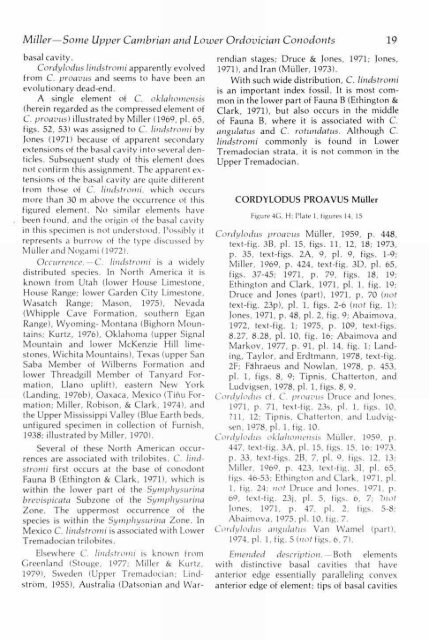View - KU ScholarWorks - University of Kansas
View - KU ScholarWorks - University of Kansas
View - KU ScholarWorks - University of Kansas
Create successful ePaper yourself
Turn your PDF publications into a flip-book with our unique Google optimized e-Paper software.
Miller-Some Upper Cambrian and Lower Ordovician Conodonts 19<br />
basal cavity.<br />
Cordylodus lindstromi apparently evolved<br />
from C. proavus and seems to have been an<br />
evolutionary dead-end.<br />
A single element <strong>of</strong> C. oklahomensis<br />
(herein regarded as the compressed element <strong>of</strong><br />
C. proavus) illustrated by Miller (1969, pl. 65,<br />
figs. 52, 53) was assigned to C. lindstromi by<br />
Jones (1971) because <strong>of</strong> apparent secondary<br />
extensions <strong>of</strong> the basal cavity into several dentidies.<br />
Subsequent study <strong>of</strong> this element does<br />
not confirm this assignment. The apparent extensions<br />
<strong>of</strong> the basal cavity are quite different<br />
from those <strong>of</strong> C. lindstromi, which Occurs<br />
more than 30 m above the occurrence <strong>of</strong> this<br />
figured element. No similar elements have<br />
been found, and the origin <strong>of</strong> the basal cavity<br />
in this specimen is not understood. Possibly it<br />
represents a burrow <strong>of</strong> the type discussed by<br />
Muller and Nogami (1972).<br />
Occurrence. - C. lindstromi is a widely<br />
distributed species. In North America it is<br />
known from Utah (lower House Limestone,<br />
House Range; lower Garden City Limestone,<br />
Wasatch Range; Mason, 1975), Nevada<br />
(Whipple Cave Formation, southern Egan<br />
Range), Wyoming- Montana (Bighorn Mountains;<br />
Kurtz, 1976), Oklahoma (upper Signal<br />
Mountain and lower McKenzie Hill limestones,<br />
Wichita Mountains), Texas (upper San<br />
Saba Member <strong>of</strong> Wilberns Formation and<br />
lower Threadgill Member <strong>of</strong> Tanyard Formation,<br />
Llano uplift), eastern New York<br />
(Landing, 1976b), Oaxaca, Mexico (Tinu Formation;<br />
Miller, Robison, & Clark, 1974), and<br />
the Upper Mississippi Valley (Blue Earth beds,<br />
unfigured specimen in collection <strong>of</strong> Furnish,<br />
1938; illustrated by Miller, 1970).<br />
Several <strong>of</strong> these North American occurrences<br />
are associated with trilobites. C. hindstromi<br />
first occurs at the base <strong>of</strong> conodont<br />
Fauna B (Ethington & Clark, 1971), which is<br />
within the lower part <strong>of</strong> the Symphysurina<br />
brevispicata Subzone <strong>of</strong> the Symphysurina<br />
Zone. The uppermost occurrence <strong>of</strong> the<br />
species is within the Symphysurina Zone. In<br />
Mexico C. lindstromi is associated with Lower<br />
Tremadocian trilobites.<br />
Elsewhere C. lindstromi is known from<br />
Greenland (Stouge, 1977; Miller & Kurtz,<br />
1979), Sweden (Upper Tremadocian; Lindstrom,<br />
1955), Australia (Datsonian and Warrendian<br />
stages; Druce & Jones, 1971; Jones,<br />
1971), and Iran (Muller, 1073).<br />
With such wide distribution, C. lindstromi<br />
is an important index fossil. It is most common<br />
in the lower part <strong>of</strong> Fauna B (Ethington &<br />
Clark, 1971), but also occurs in the middle<br />
<strong>of</strong> Fauna B, where it is associated with C.<br />
angulatus and C. rotundatus. Although C.<br />
lindstrorni commonly is found in Lower<br />
Tremadocian strata, it is not common in the<br />
Upper Tremadocian.<br />
CORDYLODUS PROAVUS Müller<br />
Figure 4G, H; Plate 1, figures 14, 15<br />
Cordylodus proavus Muller, 1959, P. 448,<br />
text-fig. 3B, pl. 15, figs. 11, 12, 18; 1973,<br />
p. 35, text-figs. 2A, 9, pl. 9, figs. 1-9;<br />
Miller, 1969, p. 424, text-fig. 3D, pl. 65,<br />
figs. 37-45; 1971, p. 79, figs. 18, 19;<br />
Ethington and Clark, 1971, pl. 1, fig. 19;<br />
Druce and Jones (part), 1971, p. 70 (not<br />
text-fig. 23p), pl. 1, figs. 2-6 (not fig. 1);<br />
Jones, 1971, p. 48, pl. 2, fig. 9; Abaimova,<br />
1972, text-fig. 1; 1975, p. 109, text-figs.<br />
8.27, 8.28, pl. 10, fig. 16; Abaimova and<br />
Markov, 1977, p. 91, pl. 14, fig. 1; Landing,<br />
Taylor, and Erdtmann, 1978, text-fig.<br />
2F; FShraeus and NowIan, 1978, p. 453,<br />
pl. 1, figs. 8, 9; Tipnis, Chatterton, and<br />
Ludvigsen, 1978, pl. 1, figs. 8, 9.<br />
Cord ylodus cf. C. proavus Druce and Jones,<br />
1971, p. 71, text-fig. 23s, pl. 1, figs. 10,<br />
?11, 12; Tipnis, Chatterton, and Ludvigsen,<br />
1978, pl. 1, fig. 10.<br />
Cordylodus oklahomensis Iler, 1959, p.<br />
447, text-fig. 3A, pl. 15, figs. 15, 16; 1973,<br />
p. 33, text-figs. 2B, 7, pl. 9, figs. 12, 13;<br />
Miller, 1969, p. 423, text-fig. 31, pl. 65,<br />
figs. 46-53; Ethington and Clark, 1971, pl.<br />
1, fig. 24; not Druce and Jones, 1971, p.<br />
69, text-fig. 23j, pl. 5, figs. 6, 7; ?not<br />
Jones, 1971, p. 47, pl. 2, figs. 5-8;<br />
Abaimova, 1975, pl. 10, fig. 7.<br />
Cordylodus angulatus Van Wamel (part),<br />
1974, pl. 1, fig. 5 (not figs. 6, 7).<br />
Emended description. - Both elements<br />
with distinctive basal cavities that have<br />
anterior edge essentially paralleling convex<br />
anterior edge <strong>of</strong> element; tips <strong>of</strong> basal cavities
















